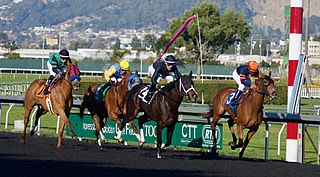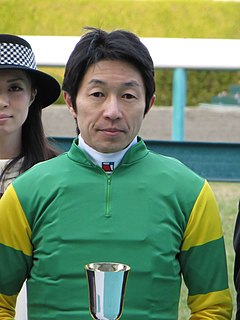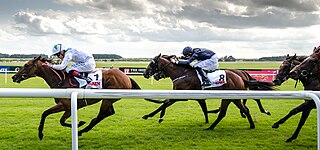
Horse racing is an equestrian performance sport, typically involving two or more horses ridden by jockeys over a set distance for competition. It is one of the most ancient of all sports, as its basic premise – to identify which of two or more horses is the fastest over a set course or distance – has been unchanged since at least classical antiquity.

The Standardbred is an American horse breed best known for its ability in harness racing, where members of the breed compete at either a trot or pace. Developed in North America, the Standardbred is recognized worldwide, and the breed can trace its bloodlines to 18th-century England. They are solid, well-built horses with good dispositions. In addition to harness racing, the Standardbred is used for a variety of equestrian activities — including horse shows and pleasure riding — particularly in the midwestern and eastern United States, and southern Ontario.

Thoroughbred horse racing is an important spectator sport in Australia, and gambling on horse races is a very popular pastime with A$14.3 billion wagered in 2009/10 with bookmakers and the Totalisator Agency Board (TAB). The two forms of Thoroughbred horseracing in Australia are flat racing, and races over fences or hurdles in Victoria and South Australia. Thoroughbred racing is the third most attended spectator sport in Australia, behind Australian rules football and rugby league, with almost two million admissions to 360 registered racecourses throughout Australia in 2009/10. Horseracing commenced soon after European settlement, and is now well-appointed with automatic totalizators, starting gates and photo finish cameras on nearly all Australian racecourses.
Group One, Group 1, Grade I or G1 is the term used for the highest level of Thoroughbred and Standardbred stakes races in many countries. In Europe, the level of races for Thoroughbred racing is determined using the Pattern race system introduced in 1971 and monitored by the European Pattern Committee. To attain or maintain a Group One status, the average rating for the first four finishers in the race must be 115 or higher over a three year period. The International Federation of Horseracing Authorities works to ensure consistent international standards. Group One races may only be restricted to age groups or a stipulated sex: they should not be restricted to horses bred in a certain country. Group One (G1) races may be run under handicap conditions in Australia, but in Europe weight-for-age conditions always apply.
The Blue Book is a publication of The Jockey Club (U.S.) which lists the highest standard of thoroughbred horseraces in the world, which are collectively known as Group races. Its publication is overseen and approved by the International Cataloguing Standards Committee (ICSC) of the Society of International Thoroughbred Auctioneers (SITA). The ICSC plays a central role as regulator of international stakes quality, and provides a process for requests to have races sanctioned as Group races.
Group races, also known as Pattern races, or Graded races in some jurisdictions, are the highest level of races in Thoroughbred horse racing. They include most of the world's iconic races, such as, in Europe, The Derby, Irish Derby and Prix de l'Arc de Triomphe, in Australia, the Melbourne Cup and in the United States, the Kentucky Derby and Breeders' Cup races. Victory in these races marks a horse as being particularly talented, if not exceptional, and they are extremely important in determining stud values. They are also sometimes referred to as Black type races, since any horse that has won one of these races is printed in bold type in sales catalogues.
The Longines World's Best Racehorse Rankings (LWBRR), known as World Thoroughbred Racehorse Rankings (WTRR) before 2012, are horseracing's equivalent to World Rankings by other major sporting organizations such as ATP Tennis Rankings, World Golf Rankings, FIFA World Rankings for soccer and IRB Rugby World Rankings. The Longines Rankings are based on the rating earned by horses running worldwide from North and South America, Europe, Middle East, South Africa, Asia through to Australia and New Zealand.

Yutaka Take is a Japanese jockey. A legend in Japan, Yutaka Take made his riding debut in 1987 and currently holds seven all-time records in his native country. Born in 1969, Take followed in his father’s footsteps, as Kunihiko Take was also a famed jockey. In 1987, the younger Take notched his first career victory at Hanshin Racecourse aboard a horse named Dyna Bishop. He ended the season as the champion apprentice with 69 winners. Two years later, he was the overall champion jockey, and Take held that title continuously until 1999, with the exception of 1991. As of 27 December 2017, the Japan Racing Association credits him with 3,945 wins, of which 323 came in graded stakes, while 75 have come in Grade 1. Take has won at least one Grade 1 for 23 straight years and a graded stakes race for 31 consecutive years. He also has the most victories in a year: 212. Although Take has ridden a number of champions, he is most associated with legendary racehorse and champion sire Deep Impact. The pair won a total of seven Grade 1 races, including the 2005 Japanese Triple Crown, and Deep Impact has gone to be the premier sire in Japan. Currently, Take is known for riding Kitasan Black, the reigning Japanese Horse of the Year. Take has also shown his abilities abroad. He has 114 wins to his credit in eight different countries, including Australia, France, Germany, Hong Kong, Korea, United Arab Emirates, United Kingdom, and the United States. A sampling of his international victories includes Group 1 wins in the Prix d'Ispahan (France) and Hong Kong Cup, two races timed by Longines, the July Cup (England) and Dubai Duty Free Stakes (UAE).
A graded stakes race is a thoroughbred horse race in the United States that meets the criteria of the American Graded Stakes Committee of the Thoroughbred Owners and Breeders Association (TOBA). A specific grade level is then assigned to the race, based on statistical analysis of the quality of the field in previous years, provided the race meets the minimum purse criteria for the grade in question. In Canada, a similar grading system is maintained by the Jockey Club of Canada. Graded stakes races are similar to Group races in Europe but the grading is more dynamic in North America.
The Breeders' Cup Juvenile Turf is an American Thoroughbred horse race for two-year-old horses, run on a grass course at a distance of one mile. It is part of the Breeders' Cup World Championships, the de facto year-end championship for North American thoroughbred racing. All Breeders' Cups to date have been conducted in the United States, with the exception of the 1996 event in Canada.
The Astoria Stakes is a long-lived race for two-year-old Thoroughbred fillies run at Belmont Park in early June during the Belmont Stakes carnival. Originally set at a distance of five furlongs, beginning in the year 1940, the event was increated to five and a half furlongs on the dirt. The race currently offers a $150,000 purse.
The Breeders' Cup Turf Sprint is a Weight for Age stakes race for thoroughbred racehorses three years old and up. As its name implies, it is a part of the Breeders' Cup World Championships, the de facto year-end championship for North American thoroughbred racing. The distance of the race will vary depending on the host track's turf course requirements.
The Breeders' Cup Juvenile Fillies Turf is a one-mile turf stakes race for thoroughbred fillies two years old. As its name implies, it is part of the Breeders' Cup World Championships, the de facto year-end championship for North American thoroughbred racing.

Horse racing in Japan is a popular equestrian sport, with more than 21,000 horse races held each year. There are three types of racing that take place in Japan - flat racing, jump racing, and Ban'ei Racing.

The Australian Stud Book (ASB), is the body responsible for ensuring the integrity of Thoroughbred breeding in Australia. Australia is the second-largest Thoroughbred breeding country in the world behind the US. The principal functions of the ASB include identification procedures along with DNA testing of mares and foals and the recording of a mare’s progeny and stallion statistics. In 2003 the ASB introduced microchips for foals, which is the most secure means of horse identification when and combined with freeze branding, provides racing officials with the most dependable identification system in the world.

Horse racing in Ireland is intricately linked with Irish culture and society. The racing of horses has a long history on the island, being mentioned in some of the earliest texts. Domestically, racing is one of Ireland's most popular spectator sports, while on the international scene, Ireland is one of the strongest producers and trainers of Thoroughbred horses. The Irish horse racing industry is closely linked with that of Great Britain, with Irish horses regularly competing and winning on the British racing circuit.
The Susan's Girl Stakes is a Thoroughbred horse race run annually at Gulfstream Park, in Hallandale Beach, Florida for two-year-old fillies at a distance of seven furlongs on dirt. It is part of the eleven-race Florida Thoroughbred Breeders' & Owners' Association (FTBOA) Florida Sire series of which seven races are hosted by Gulfstream Park and four by Tampa Bay Downs.
The Desert Vixen Stakes is a Thoroughbred horse race run annually at Gulfstream Park, in Hallandale Beach, Florida for two-year-old fillies at a distance of six furlongs on dirt. It is part of the eleven-race Florida Thoroughbred Breeders' & Owners' Association (FTBOA) Florida Sire series of which seven races are hosted by Gulfstream Park and four by Tampa Bay Downs.













